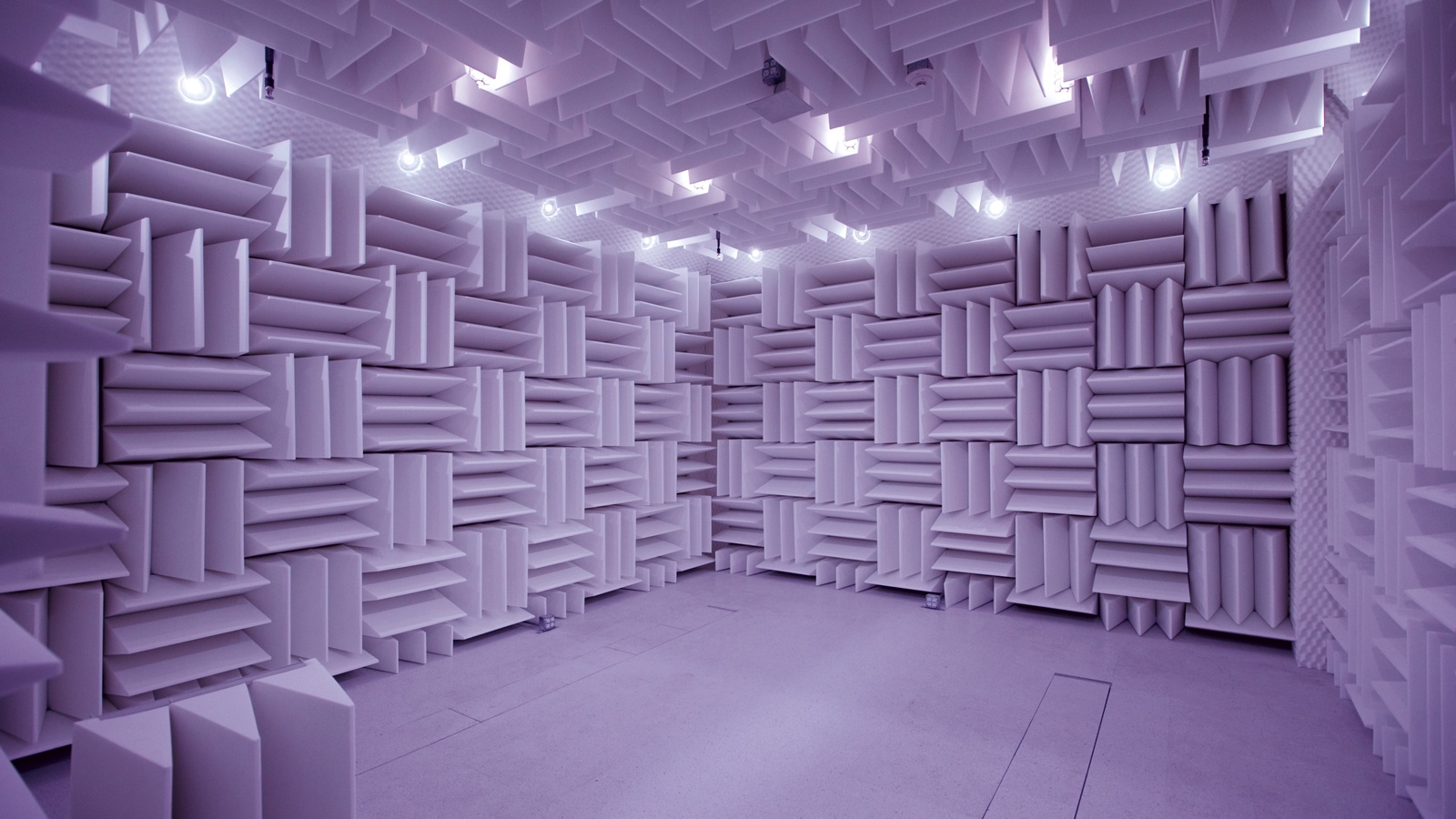Engineering a quiet place


Engineering a quiet place
by Caramel Quin | Engineering + Technology, August 2024
It was – and still is – the spookiest experience of my life. I was standing in an anechoic chamber, designed to cut out all noise, and it felt deeply disturbing. There was absolute silence. Even my breath was silent. Speech sounded weirdly muted because there was no echo at all. The hairs rose on the back of my neck and tingled. After a while, I realised I could hear my own pulse, which was a small comfort. No one stays in an anechoic chamber for long: the sensory deprivation makes people hallucinate.
An anechoic chamber is insulated from external noises and designed to minimise the reflection of sound waves inside. It’s the opposite of everyday life. If you’re sitting in a quiet room right now, pause and listen. Maybe you can hear the hum of traffic, birdsong, your laptop’s fan, a distant television. Quiet isn’t quiet any more.
Lockdown saw us forced to spend more time in our own homes. Traffic noise was blissfully quiet for a short time but then resumed. Suddenly working from home made us realise how very loud everyday life is, even outside of cities. The sound of the fridge compressor really began to grate, and why do appliances insist on beeping?
What is noise?
To talk about noise, we must first understand sound and how it’s measured.
“Sound is a pressure wave, so in acoustics the only real way to measure it is in pascals,” says Tom Richards, Dyson’s senior engineering manager, acoustics and vibration. “Decibels are a way of converting units that don’t make sense linearly. We hear in a logarithmic way so decibels are just a way of making those numbers make a little bit more sense.”
There are multiple types of decibel, but sound pressure level is the most common use of the unit. Sound pressure level changes depending on what environment you test in, so Dyson prefers to measure a device’s sound power level (Watts) in semi-anechoic chambers.
“The sound power level of your vacuum cleaner is the same, whether you’re in a cathedral or a bathroom or a lab. It doesn’t change, but the sound pressure level does because the environment’s changed,” explains Richards.
We’ll stick with the more intuitive unit of decibels to talk about noise because it more closely relates to how we hear sound. And noise is simply unwanted sound. If a weed is a plant in the wrong place, a noise is a sound in the wrong place. And it’s subjective: it’s common to like birdsong but dislike the sound of a passing car. If you share your neighbour’s music taste, their hi-fi is less annoying.
Aural diversity - What’s that sound?
Noise is subjective and affects each of us differently. For example, some neurodivergent people get sensory overload where sounds are overwhelming. In fact, there’s no such thing as ‘normal’ when it comes to hearing. We’re a very diverse bunch.
“The premise of aural diversity is that much work, for example noise regulations, assume ‘normal hearing’,” says Cox. “But so-called ‘normal hearing’ is what most young adults have, and only represents about 17% of the population.”
His colleague Bill Davies runs a new Leverhulme Trust Aural Diversity Doctoral Research Hub (LAURA). From cities to music to consumer electronics, everything is designed for a ‘normal’ listener that doesn’t exist. People who hear differently, like a musician with tinnitus, a lip-reading churchgoer or an autistic student, are marginalised by the assumption. LAURA seeks to transform thinking to include the whole spectrum of aural experience.
Slave to the rhythm
“Sound affects our brain waves, our heart rate, our hormone secretion, all our physical rhythms,” says Poppy Szkiler, founder and CEO of Quiet Mark. “Designing or engineering with best practice acoustics and quiet products supports increased concentration, decreases anxiety, reduces stress, aids better sleep and improves health recovery.”
The World Health Organization (WHO) considers noise pollution not only an environmental nuisance but also a threat to public health. The WHO report Burden of disease from environmental noise: Quantification of healthy life years lost in Europe outlines health impacts including cardiovascular disease, cognitive impairment, sleep disturbance and tinnitus.
It says, for example, that at least a million healthy life years are lost annually from traffic-related noise in western Europe. Importantly, this is the impact of noise alone, not combined with other factors such as air pollution.
But isn’t innovation making new products quieter? Yes and no… put simply, they are but we’re using lots more of them.
“Individual vehicles have got quieter, but we have many more of them on the road,” says Professor Trevor Cox, head of the Acoustics Research Centre at the University of Salford. “And as people try to avoid gridlock, rush hour extends over longer times and rat runs get more traffic. The ‘average’ noise level is not too different, but we’re losing the quiet times and quiet places. These refuges from noise are really important, as is trying to preserve them.”
WHO research on noise exposure has fed into UK noise regulations, which recommend a ‘noise dose’. So, eight hours of 84dB is equivalent to being exposed to four hours of 87dB or two hours of 90dB. And the same is true for products in the home.
“This is one of the reasons our vacuum cleaners have different modes: so that people can choose the noise level that they want,” says Richards. “If your baby is asleep or you’re sensitive to noise, use Eco mode and you can vacuum for longer and get a very low dose of noise. Or put it in Boost mode for a specific spot. You still get a relatively low dose of noise, even though it’s much louder, because you’re only using it for a very short period of time.”
Noise problems are cumulative. Sounds from different sources tend to be incoherent and add up. Coherent sounds (same frequency, same wavelength, constant phase difference) can add up or cancel each other out. Noise-cancelling headphones make use of this by listening to external background noise and playing you the ‘opposite’ of it, a sine wave that’s coherent but half a cycle out of phase, to cancel it out. That’s why noise-cancelling headphones are best at tackling a consistent background hum: trains, planes and automobiles.
The sound of science
Cancelling, insulating against and absorbing sound have their uses, but it’s preferable to design out noise in the first place: for example, the pricey perfectionism of balancing Dyson’s latest Hyperdymium motor to cut vibration, so the shell doesn’t shake and make noise. The Gen5Detect vacuum cleaner is Dyson’s fastest yet, spinning at up to 135,000 revolutions a minute, nine times faster than a Formula One engine.
“Every rotor is individually balanced,” explains Richards. “It’s measured very accurately and then a milling cutter cuts a little bit of the impeller off. So every single rotor is slightly different.”
Sound quality matters too. Decibels only measure how loud something is, but some sounds are more annoying than others. Cox uses drones as an example: “Take a quadcopter. They aren’t that loud but they have a nasty quality to the sound, like an angry insect. In research we have psychoacoustic metrics that try to capture qualities beyond dB.”
Psychoacoustics is the science of how sounds are perceived. Cox adds that context is important: “Not having control over a noise makes it more annoying. If you work at an airport, you’re probably less likely to complain about the sound under the flightpath because your livelihood depends on it.”
There’s also the matter of taste. Some sounds are universally loved or loathed, others are subjective. Dyson has a team of ‘golden listeners’ chosen for having a good ear and then trained to be great at assessing sound quality, whether that’s tuning the sound from Dyson Zone headphones or flagging which product noises are annoying.
Quiet Mark tests and verifies more than 80 product categories to provide that information free globally to consumers, architects and specifiers. “Our strategy is, if we all buy quiet, design quiet and specify quiet products, we can collectively eventually beat noise pollution,” says Szkiler.
Assistive devices - Hearingaids that aren’t hearing aids
The number of people with hearing loss is growing and not just because of our ageing population. Decades of loud music and video games are also taking their toll. Generation X have a double-whammy, they grew up with a Walkman and are hitting their 50s and 60s now.
“There is still a stigma about hearing aids,” says Cox. “A large number of people who could benefit from them don’t have them or don’t wear them often enough.”
A new category of not-quite-hearing-aids, that look more like AirPods than assistive devices, are aimed at those who don’t feel ready for a hearing aid. For example, the Signia Active Pro is aimed at people with mild to moderate hearing loss, looks like earbuds and uses an AI-powered assistant to adapt to environments.
There are even apps that use your smartphone’s mic to pick up sound and amplify it to your headphones, although it’s a much more blunt instrument than a hearing aid. You might think of it as an ear trumpet for the 21st century.
Designing out the hum
Absorbing sound is the next line of defence. Much research is going into composite structures called metamaterials.
“Low-frequency sound has a very large wavelength, so attenuating low frequencies requires very large structures,” says Cox. “Metamaterials have the potential to allow control of noise from much thinner materials.”
Natural materials have their uses too and embody much less carbon. Hedges help block high frequencies but are less useful for road noise. Royal Horticultural Society-funded research is looking at how to maximise their noise reduction.
“This might be about combining hedges with hard landscaping or choosing the right species to grow,” says Cox.
Of course, a return to planting hedges would have the side effect of increasing habitat. This is much needed and would help boost one sound we universally enjoy, and rarely consider to be noise: birdsong.
This article is adapted from the Engineering and Technology article “Engineering a quiet place”.
Click here to view the original and unabridged Engineering + Technology article


 Quiet Mark Founder
Quiet Mark Founder